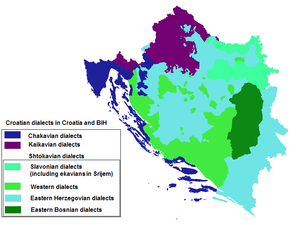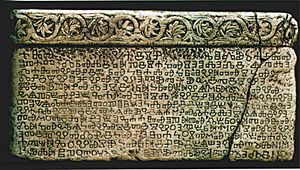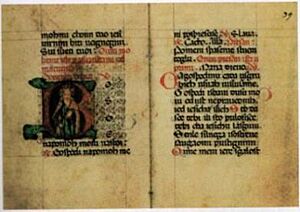Croatian language facts for kids
Quick facts for kids Croatian |
||||
|---|---|---|---|---|
| hrvatski | ||||
| Native to | Croatia, Bosnia and Herzegovina, Serbia (Vojvodina), Montenegro, Romania (Caraș-Severin County), Slovenia, and diaspora | |||
| Native speakers | 5.55 million (2001) | |||
| Language family |
Indo-European
|
|||
| Writing system | Latin (Gaj's alphabet) Croatian Braille |
|||
| Official status | ||||
| Official language in | ||||
| Recognised minority language in | ||||
| Regulated by | Institute of Croatian Language and Linguistics | |||
| Linguasphere | part of 53-AAA-g | |||

Traditional extent of Serbo-Croatian dialects in Croatia and in Bosnia and Herzegovina
|
||||
|
||||
The Croatian language is spoken mainly in Croatia and Bosnia and Herzegovina. You can also hear it in nearby countries in Europe and where Croatians live around the world.
Croatian is part of the Slavic language family. It has three main ways of speaking, called dialects: Kaikavian, Chakavian, and Shtokavian. The rules for Croatian grammar started to be written down a long time ago.
The first Croatian grammar book was written in Latin in 1604 by Bartol Kašić. This means that the rules for how the language works were officially recorded. Between 1604 and 1836, 17 different grammar books were created. Most of them focused on the Shtokavian dialect, but some also described the Kajkavian dialect.
In the 19th century, more grammar books were written based on Shtokavian. Important ones include "Nova ricsoslovnica illiricka" by Šime Starčević (1812) and "Grammatik der illyrischen Sprache" by Ignjat Alojzije Brlić (1833). Before the 19th century, all three Croatian dialects were used quite equally. However, how they were written down changed depending on the region. For example, near the Adriatic Sea, writing was more like Italian. Near the Hungarian border, it was more like Hungarian.
Early grammar books (from 1604-1836) used three special marks called accents: acute, grave, and circumflex. Starčević's grammar was different because it used a system with four accents. In the 19th century, Ljudevit Gaj suggested adding new letters from the Czech alphabet (like č, ž, š). He also suggested 'ć' from Polish. Other sounds were written using two letters together, like 'lj', 'nj', and 'dž'. Later, 'dj' or 'gj' was changed to 'đ' based on a suggestion by Đuro Daničić.
Contents
How Croatian is Written: The Alphabet
The Croatian language uses a Latin alphabet with 30 letters. It also has one special sound called a diphthong, "ie" or "ije", and "ŕ". This writing system is called gajica in Croatian. It is named after Ljudevit Gaj, who helped create it.
The order of the letters in the alphabet is called abeceda in Croatian. This name comes from the first four letters: "a, be, ce, de". When writing foreign names or words, or in some special jobs, Croatian uses letters that are not part of gajica, like "X, x (iks)" and "Y, y (ipsilon)".
Croatian alphabet (Gaica) 1830.c
How Words Change: Grammatical Cases
In Croatian, nouns (words for people, places, or things) change their endings depending on how they are used in a sentence. This is called declension. It can be one of the trickiest parts of learning Croatian!
Even though it's complex, many languages have declension. English, for example, used to have it for nouns, but now it mostly only has it for pronouns (like "I" changing to "me" or "my").
Croatian has seven grammatical cases, called padeži (plural) or padež (singular). A common way to figure out which case to use is by asking a question.
- Example:
- Let's see how to find a noun's grammatical case using the table below.
- Krešimir is going to school. (Krešimir ide u školu.)
The question you would ask here is: "Where is Krešimir going?" The answer is "to school." If you look at the table, you'll see that "where?" is a question for the Locative case.
| Grammatical case | The question you ask yourself | Example |
|---|---|---|
| Nominativ (Nominative) | Tko? Što? (Who or what?) | Jabuka je fina. (The apple is delicious.) |
| Genitiv (Genitive) | Koga? Čega? Čiji? (Whom? Of what? Whose?) | Ovo radim zbog jabuke. (I'm doing this because of the apple.) |
| Dativ (Dative) | Komu? Čemu? (To whom or to what am I going?) | Idem prema jabuci. (I am going toward the apple.) |
| Akuzativ (Accusative) | Koga? Što? (Whom or what do I see?) | Ne vidim jabuku. (I do not see the apple.) |
| Vokativ (Vocative) | Oj! Ej! (Oh! Hey!) | Oj, jabuko! (Oh, apple!) |
| Lokativ (Locative) | Gdje? U komu? U čemu? (Where? In whom? In what?) | Živim u jabuci. (I live in the apple.) |
| Instrumental | S kime? S čime? (With whom or with what?) | Trčim s jabukom. (I am running with the apple.) |
Word Types: Gender in Croatian
Croatian nouns are divided into three genders: masculine, feminine, and neuter. Knowing a noun's gender is super important! It changes how other words in the sentence, like adjectives (describing words), will look.
You can often tell a noun's gender by its ending, which makes it easier than memorizing every single word. There are a few exceptions, but this rule helps a lot. Even when nouns become plural (more than one), they keep their original gender. For example, 'žena' (woman) is feminine, and 'žene' (women) is still feminine, even though it ends in '-e'.
| Ending | -a | -e, -o | -k, -l, -r, -d... (and all other letters) |
|---|---|---|---|
| Gender | Feminine | Neuter | Masculine |
| Example | žena (woman) | sunce (sun) | metak (bullet) |
Verb Actions: Grammatical Aspects
Croatian verbs have two grammatical aspects: perfective and imperfective. These aspects show if an action is finished or still going on.
- The perfective aspect describes an action that has already been completed.
- The imperfective aspect describes an action that is still happening or is ongoing.
So, for almost every verb, you can write it in two ways: one for a finished action and one for an ongoing action. The table below shows five verbs in both their imperfective (ongoing) and perfective (finished) forms.
| Imperfective aspect (ongoing action) | Perfective aspect (finished action) |
|---|---|
| Trčati. (To run. An ongoing action.) | Odtrčati. (To run off. The running is finished.) |
| Sjediti. (To sit. An ongoing action.) | Sjesti. (To sit down. The action of sitting down is finished.) |
| Plivati. (To swim. An ongoing action.) | Odplivati. (To swim away. The swimming is finished.) |
| Graditi. (To build. An ongoing action.) | Izgraditi. (To build up/finish building. The building is finished.) |
| Popravljati. (To fix/repair. An ongoing action.) | Popraviti. (To fix/repair. The fixing is finished.) |
When Actions Happen: Grammatical Tenses
Croatian has seven grammatical tenses, which tell you when an action takes place. They can be simple or complex.
- Simple tenses use only one word (like aorist, imperfect, and present).
- Complex tenses use two or even three words (like pluperfect, perfect, first future, second future). They often use helping verbs.
Also, some tenses can only be formed with either perfective or imperfective verbs, not both.
| Tense | What it describes | Example |
|---|---|---|
| Pluperfect | An action that happened before another past action (like "had eaten" in English). | Mladen je bio ručao. (Mladen had had lunch.) |
| Imperfect | A past action that was unfinished or happened repeatedly. Only uses imperfective verbs. | Mladen trčaše. (Mladen was running.) |
| Aorist | A past action that was completed quickly. Not used much today. Only uses perfective verbs. | Mladen odtrčaše. (Mladen ran off and finished.) |
| Perfect | The main past tense. Can use both imperfective and perfective verbs. | Mladen je trčao. (Mladen was running). |
| Present | An action happening now. | Mladen ruča. (Mladen is having lunch.) |
| First future | An action that will happen in the future. | Mladen će ručati. (Mladen will have lunch.) |
| Second future | An action that will happen before another future action. | Ako bude kiša uskoro pala, suša će prestati. (If rain soon falls, the drought will end.) |
Useful Croatian Phrases
- Basic and common expressions:
| Croatian | English |
|---|---|
| Da | Yes |
| Ne | No |
| Što | What |
| I | And |
| Ili | Or |
| Bok | Hi, bye |
| Zbogom | Goodbye |
| Dobar dan | Good day |
| Dobro jutro | Good morning |
| Dobra večer | Good evening |
| Laku noć | Good night |
| Možda | Maybe |
| Kada | When |
| Gdje | Where |
| Kako | How |
| Hvala | Thanks |
| Dođi | Come |
| Koliko | How much / How many |
- Colours:
| Croatian | English |
|---|---|
| Zlatna | Golden |
| Zelena | Green |
| Crvena | Red |
| Žuta | Yellow |
| Smeđa | Brown |
| Narančasta | Orange |
| Crna | Black |
| Plava | Blue |
| Ružičasta | Pink |
| Ljubičasta | Purple |
| Siva | Grey |
| Bijela | White |
| Tirkizna | Turquoise |
| Srebrna | Silver |
- Days, months & seasons
The Croatian week starts with Monday and ends with Sunday. This is different from some countries where Sunday is the first day.
- Days:
| Croatian | English |
|---|---|
| Ponedjeljak | Monday |
| Utorak | Tuesday |
| Srijeda | Wednesday |
| Četvrtak | Thursday |
| Petak | Friday |
| Subota | Saturday |
| Nedjelja | Sunday |
- Months:
| Croatian | English |
|---|---|
| Siječanj | January |
| Veljača | February |
| Ožujak | March |
| Travanj | April |
| Svibanj | May |
| Lipanj | June |
| Srpanj | July |
| Kolovoz | August |
| Rujan | September |
| Listopad | October |
| Studeni | November |
| Prosinac | December |
| Croatian | English |
|---|---|
| Sjever | North |
| Jug | South |
| Istok | East |
| Zapad | West |
| Gore | Up |
| Dolje | Down |
| Lijevo | Left |
| Desno | Right |
- Prepositions
| Croatian | English |
|---|---|
| Na | On |
| Uz | By |
| Ispod/pod | Under, below |
| Iznad/nad/ober | Above |
| U | In |
| Ispred | In front of |
| Iza | Behind |
- Numbers
| 0 - Nula |
|---|
| 1 - Jedan |
| 2 - Dva |
| 3 - Tri |
| 4 - Četiri |
| 5 - Pet |
| 6 - Šest |
| 7 - Sedam |
| 8 - Osam |
| 9 - Devet |
| 10 - Deset |
| 11 - Jedanaest |
| 12 - Dvanaest |
| 13 - Trinaest |
| 14 - Četrnaest |
| 15 - Petnaest |
| 16 - Šesnaest |
| 17 - Sedamnaest |
| 18 - Osamnaest |
| 19 - Devetnaest |
| 20 - Dvadeset |
| 30 - Trideset |
| 40 - Četrdeset |
| 50 - Pedeset |
| 60 - Šezdeset |
| 70 - Sedamdeset |
| 80 - Osamdeset |
| 90 - Devedeset |
| 100 - Sto |
| 1,000 - Tisuću |
| 1,000,000 - Milijun |
| 1,000,000,000 - Milijarda |
How Croatian Compares to Serbian
Croatian and Serbian are very similar languages, but they have some differences in vocabulary. This table shows some words that are different between the two languages.
| English | Croatian | Serbian |
|---|---|---|
| Compare | Usporedba | Поређење (Poređenje) |
| Europe | Europa | Европа (Evropa) |
| Netherlands | Nizozemska | Холандија (Holandija) |
| Italians | Talijani | Италијани (Italijani) |
| Universe | Svemir | Васиона (Vasiona) |
| Spine | Kralježnica | Кичма (Kičma) |
| Air | Zrak | Ваздух (Vazduh) |
| Education | Odgoj | Васпитање (Vaspitanje) |
| Week | Tjedan | Седмица (Sedmica) |
| History | Povijest | Историја (Istorija) |
| Pants | Hlače | Панталоне (Pantalone) |
| Belly | Trbuh | Стомак (Stomak) |
| Science | Znanost | Наука (Nauka) |
| Personally | Osobno | Лично (Lično) |
| Person | Osoba | Лице (Lice) |
| United Nations | Ujedinjeni Narodi | Уједињене Нације (Ujedinjene Nacije) |
| Bread | Kruh | Хлеб (Hleb) |
| Artificial | Umjetno | Вештачки (Veštački) |
| Cross | Križ | Крст (Krst) |
| Democracy | Demokracija | Демократија (Demokratija) |
| Knowledge | Spoznaja | Сазнање (Saznanje) |
| Island | Otok | Острво (Ostrvo) |
| Officer | Časnik | Официр (Oficir) |
| Road traffic | Cestovni promet | Друмски саобраћај (Drumski saobraćaj) |
| Highway | Autocesta | Аутопут (Autoput) |
| Length | Duljina | Дужина (Dužina) |
| Association | Udruga | Удружење (Udruženje) |
| Factory | Tvornica | Фабрика (Fabrika) |
| General | Opće | Опште (Opšte) |
| Christ | Krist | Христoс (Hristos) |
| I'm sorry | Oprosti | Извини (Izvini) |
| Native language standard | Materinski jezićni standard | Матерњи језички стандард |
Images for kids
See also
 In Spanish: Idioma croata para niños
In Spanish: Idioma croata para niños





